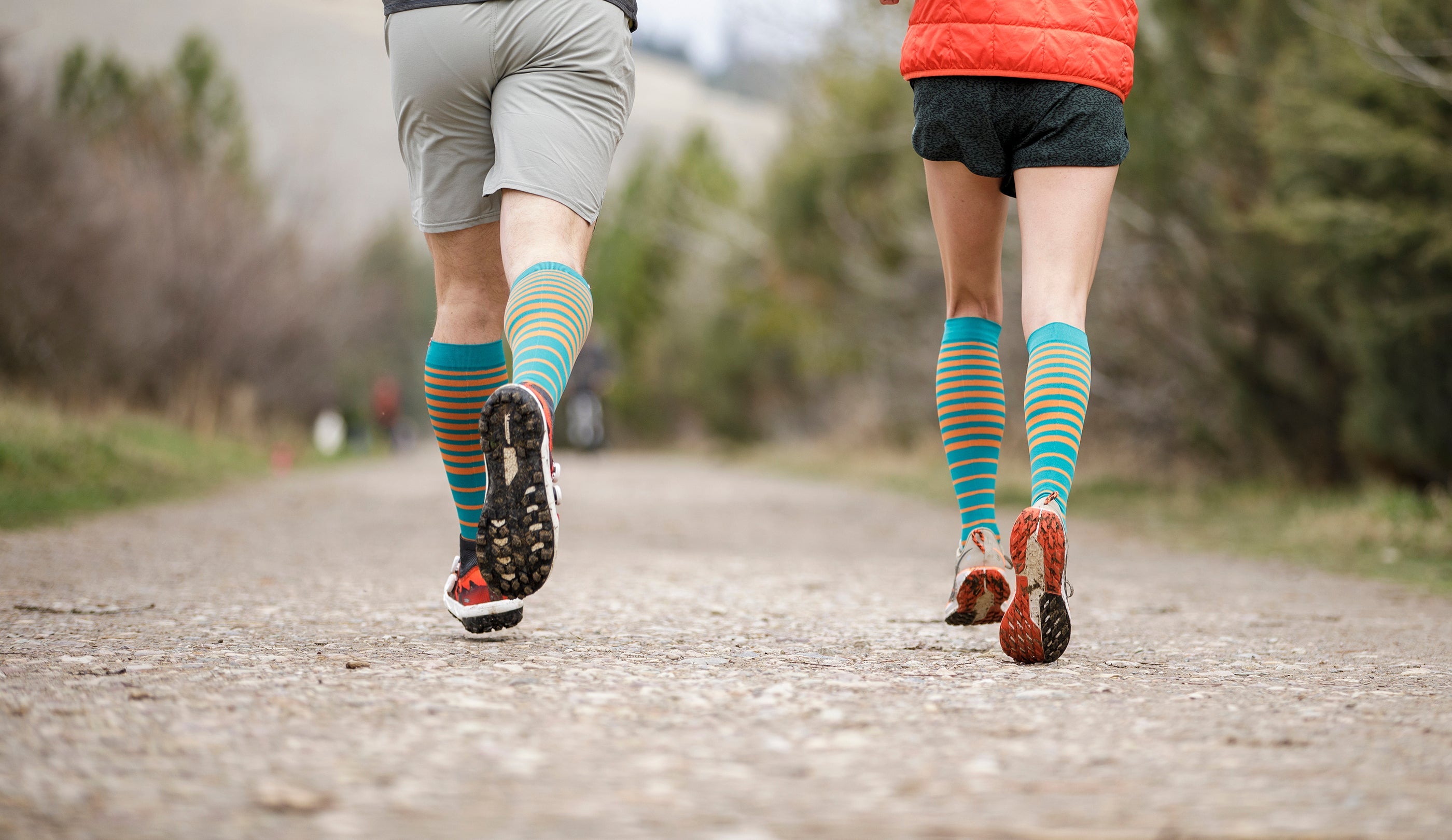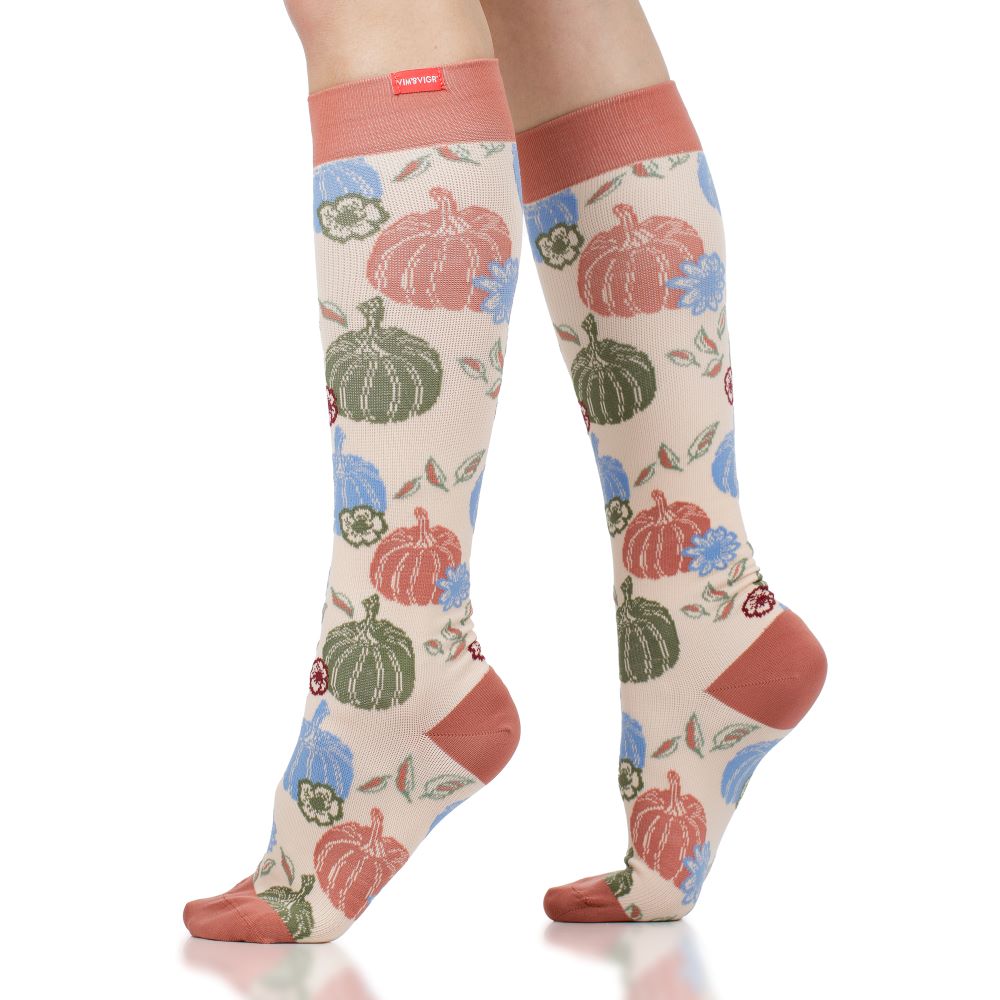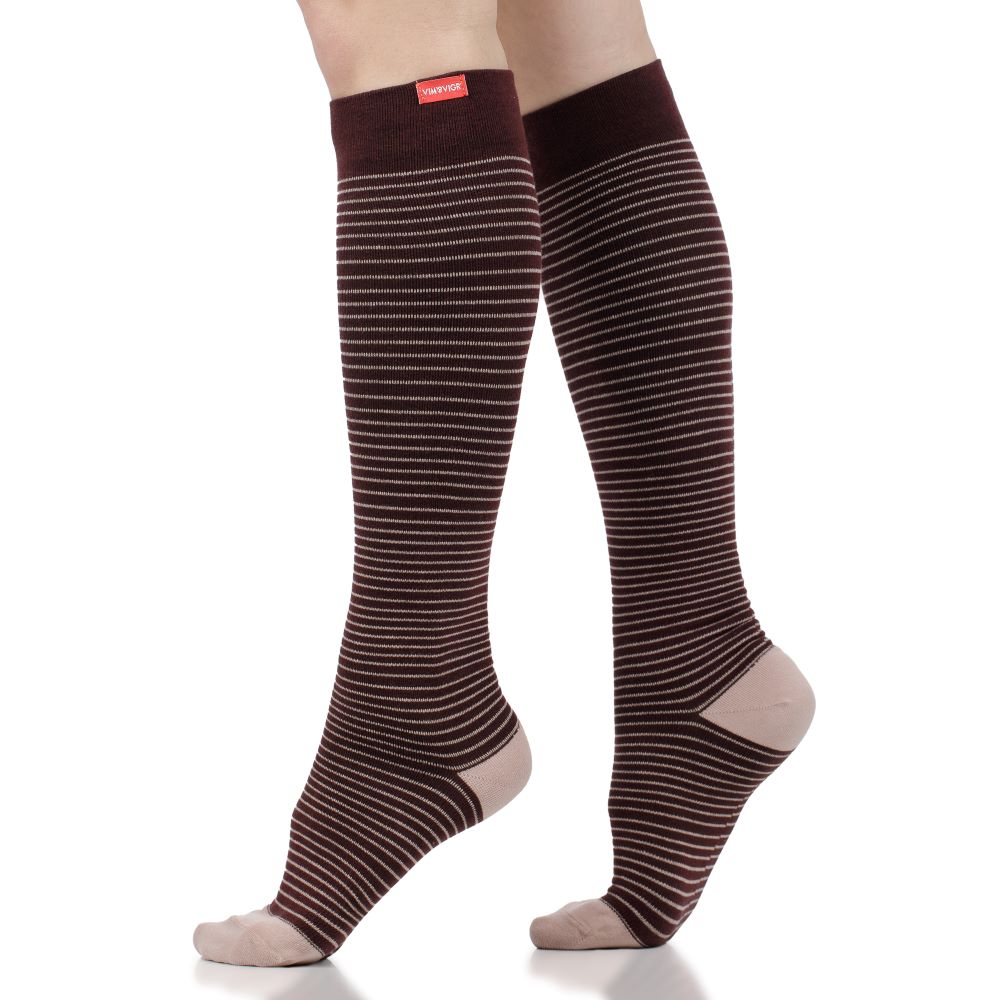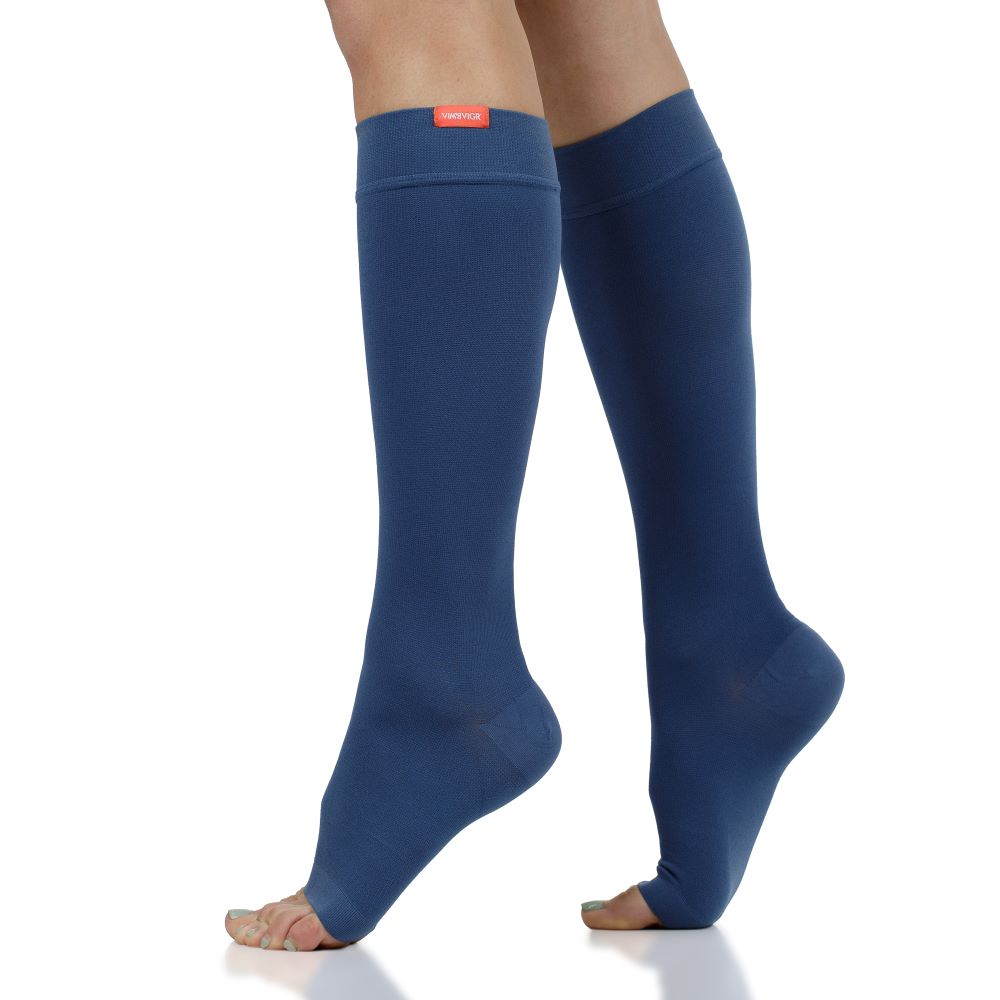Compression Socks for Bunions: Can They Really Help?
Bunions can often be uncomfortable, unsightly, and simply unwelcome. They can cause us incredible discomfort, especially when rubbing against shoes and when we’re on our feet for long periods of time. Luckily, we can reduce friction, improve support and comfort levels, and feel better and more energized with compression socks.
Can compression socks help with bunions? Although they are bony bumps that cannot be treated or removed with compression, bunions are made worse by friction and foot discomfort. Compression socks and stockings help reduce these and boost your well-being.
Read on to find out the benefits of compression against bunions and how to choose the best pair of socks for you, as well as complementary strategies to keep your feet feeling fresher and more energized.
Are Compression Socks Good For Bunions?
As they grip the foot tightly and provide support throughout the day, compression socks reduce the risk of friction, which makes pain from bunions less likely to occur. They also boost blood flow in the lower limbs, energizing the feet and reducing swelling and discomfort overall.
Moreover, compression socks can help relieve pain, irritation, and localized swelling caused by bunions. The combination of increased peripheral blood flow and massage they provide works to reduce inflammation and stimulate circulation, which brings down swelling.
What Are Bunions and How Can Compression Socks Help?
Bunions are bony outgrowths on our feet, most often at the big toe joint, but also found on the outside of the foot at the little toe joint. They are caused by drifting of the toes inwards, often because of our footwear. Since women tend to wear narrower, pointier shoes, they are more likely to develop bunions, especially as they age. Some bunions are also hereditary, while sometimes, an injury could also cause a change in gait and a subsequent bunion.
You may have heard of bunions referred to as “hallux valgus” - this is the medical term for them. While many people will have mild symptoms of pain and irritation associated with their bunions, for some, surgery could be required to remove them. However, for the majority, changing shoes to something more comfortable and wearing appropriate socks can make a world of difference.
Compression socks hold on to feet tightly, while stimulating peripheral circulation and delivering a whole range of benefits to the limbs and the body as a whole. Their blood flow boosting effects and the gentle massage they apply to the feet and legs help bring down inflammation and swelling. Primarily, however, they eliminate friction and sources of irritation for your bunions, since they stay in place and are made from skin-loving materials that should reduce your risk of bunion pain.
Benefits of Compression Socks for Bunions
Bunions create localized irritation and discomfort. Over time, they can also cause pain throughout the foot, as the medial dorsal cutaneous nerve (which runs over the bunion) becomes inflamed. Moreover, since the toe joints get more pressure when you spend a lot of time on your feet, your lifestyle or job can also make you feel more pain when you have bunions. In all these cases, compression socks can provide help and support.
Pain Relief
Pain caused by bunions falls under two categories: the immediate pain and irritation from rubbing against the shoe and the longer-term, more profuse pain caused by pressure on the joints and inflammation of the nerves. Good-quality compression socks address both of these.
Since they apply pressure to the lower limbs through tight material that grips well onto the feet, compression socks reduce the risk of friction and associated irritation. This is why they’re a garment of choice in many sports, such as running and tennis, where athletes move a lot. Additionally, because compression socks stimulate blood flow in the lower limbs and reduce the risk of inflammation and swelling, they can be an effective long-term tool against pain from bunions.

Reduced Swelling and Inflammation
The increase in blood flow thanks to compression socks helps reduce inflammation in the feet and brings down swelling. Both of these bunion symptoms can be treated once they’ve happened, or you can wear compression socks preventively, to help lower the risk of swelling before it happens.
This is particularly relevant to those who spend a long time on their feet, such as hairdressers or nurses. Avoiding the growing pressure that standing puts on the feet should reduce inflammation around your bunion and keep it from starting to hurt. Similarly, since graduated compression socks stimulate blood flow from the feet back up to the heart, they reduce your risk of having blood and fluid pool around the lower limbs and making them swell, which will cause feet and legs to hurt more.
Enhanced Comfort
Compression socks are not just great at boosting circulation. They provide you with an ongoing gentle massage of the muscles and joints, plus added support and sometimes extra padding for the feet. This means that they keep lower legs and feet more comfortable throughout the day, reducing the risk of feeling sore and “heavy legs.”
At the same time, the tight grip that compression socks apply to the feet improves comfort for those suffering from bunions. It prevents extra friction with your shoes. Moreover, compression socks come in comfortable fabrics like merino wool, which is hypoallergenic and an excellent thermal regulator - keeping your feet warm or cool, depending on the weather, and always happy and dry.
Improved Support and Alignment
Sometimes, bunions are caused by a change in your gait, often as a result of injuries like plantar fasciitis. Compression socks are one of the many tools to help you deal with these injuries, speeding up recovery and providing better support to the foot and ankle.
For those suffering from advanced bunion pain from the big toe, there is also the option of wearing a split-toe design of sock, which moves the big toe away from the rest of the toes and helps reduce some of the lump created by the bunion.
Prevention of Further Complications
While a bunion is not the end of the world and can be managed relatively easily most of the time, it can also cause further problems in time. You may start to find it harder to move the toes and you can grow corns and calluses on the affected ones. Moreover, studies show that bunions increase the risk of osteoarthritis in the big toe joint, leading to chronic pain.
Reducing the severity of your bunion by wearing compression socks and appropriate shoes can reduce these risks. You’ll be boosting blood flow and massaging the feet, allowing irritation and pain to subside and helping support and re-align the toes. Wearing compression garments can also prevent bunions from showing up in the first place, by keeping a better posture and peripheral circulation.
Choosing the Best Bunion Relief Socks
To get the most out of your bunion compression socks, you need to ensure they fit right - from pressure levels to sizing, and including how adapted they are to your lifestyle and activity levels. Here’s all you need to know.
Understanding Compression Levels
All compression garments are not identical - there are different levels of pressure applied to the limbs, measured in mmHg. For compression socks, here’s a primer on what these mean:
- 15-20 mmHg - all-day wear, gentle compression that feels comfortable enough to wear for a long period of time, for example, at work or when traveling;
- 20-30 mmHg - firmer compression that is more suited to people with circulatory conditions like deep vein thrombosis or varicose veins;
- 30-40 mmHg - medical grade compression that you can get on prescription only, but which can be good for recovering from surgery or injuries or when suffering from more serious conditions like venous insufficiency.
You should also ensure that your socks fit optimally by following a sizing guide before you order.
Considering Compression Sock Types
While knee-high compression socks are the best known and most common, those who suffer from bunions can also benefit from fuller coverage with compression tights.
Ensuring Optimal Comfort and Effectiveness
Your compression socks or tights will be at their most effective when they’re worn correctly. This means avoiding any bunching or folding in the material and ensuring that your toes and heels are nestled into their respective extremities. Compression socks should feel firm and supportive, but not so tight that they cut off your circulation. On the other hand, if they are too loose, they won’t benefit you in any special way.
When and How Long to Wear Compression Socks for Bunions
It’s a good idea to wear compression socks as a preventative measure to avoid swelling and pain in the lower legs if you spend a lot of time standing. Jobs where you are always on your feet put a lot of pressure on the joints and bones, raising your risk of developing bunions. This is made worse if you wear tighter fitting shoes, which make your toes point inwards instead of splaying naturally.
If you wear your socks for everyday prevention, you can start by putting them on for a couple of hours while you get used to the feeling of compression. In time, you can increase this depending on how comfortable you feel.
Once you’ve noticed a bunion and are feeling the pain and irritation associated with it, compression socks can still provide relief and a tight fit that avoids any unnecessary rubbing that can make you feel worse. Again, if you’re unfamiliar with compression socks, start by wearing them for a couple of hours at first. Then, gradually increase how long you keep them on.
Supporting Strategies for Bunion Relief
In most cases, you can get relief from bunion pain by changing shoes and resting in the first instance. The main priority will be to reduce pressure on the big toe to start, then increase the range of motion of all your toes.
Ice and Rest
Ice can numb the painful area and rest (especially without tight-fitting shoes) will immediately remove pressure from the feet. These are temporary, quick fixes, but they are effective when you first feel a strong attack of inflammation.
Choosing Appropriate Footwear
For the longer term, changing your footwear for models with wider toe boxes will help you manage bunions and reduce their impact on your everyday life. Wider shoes avoid rubbing and irritating the bunion and let the toes splay out more naturally. You can also opt for flip flops and sandals (but be careful that they don’t feature straps that hold your toes close together - some of those may even cross over your bunion and prove painful).
Foot Exercises and Stretches
Finally, some stretches and foot strengthening exercises could help you feel better, reducing pressure on the bunion, and improving your toes’ range of motion. Here are some ideas you can start with:
- With bare feet, focus on moving only the big toe outwards, horizontally. This will feel difficult / odd at first, but it improves with practice;
- Perform a “Mexican wave” with your toes, raising them all up and then slowly bringing them down one by one, starting with the little toe. Reverse the order;
- Work on deliberately splaying the toes out on a mat. Try not to lift them when you do this;
- Make a “short foot” - with toes firmly on the floor, try and shorten your foot by pulling them back, using the muscles in your feet. Don’t scrunch your toes and don’t lift the middle of the foot. You should move very little at first, but, in time, this will strengthen your arches and your feet overall;
- Work a massage or tennis ball into the arch of the foot, relaxing any points of tension and loosening the foot as much as possible.






















Leave a comment